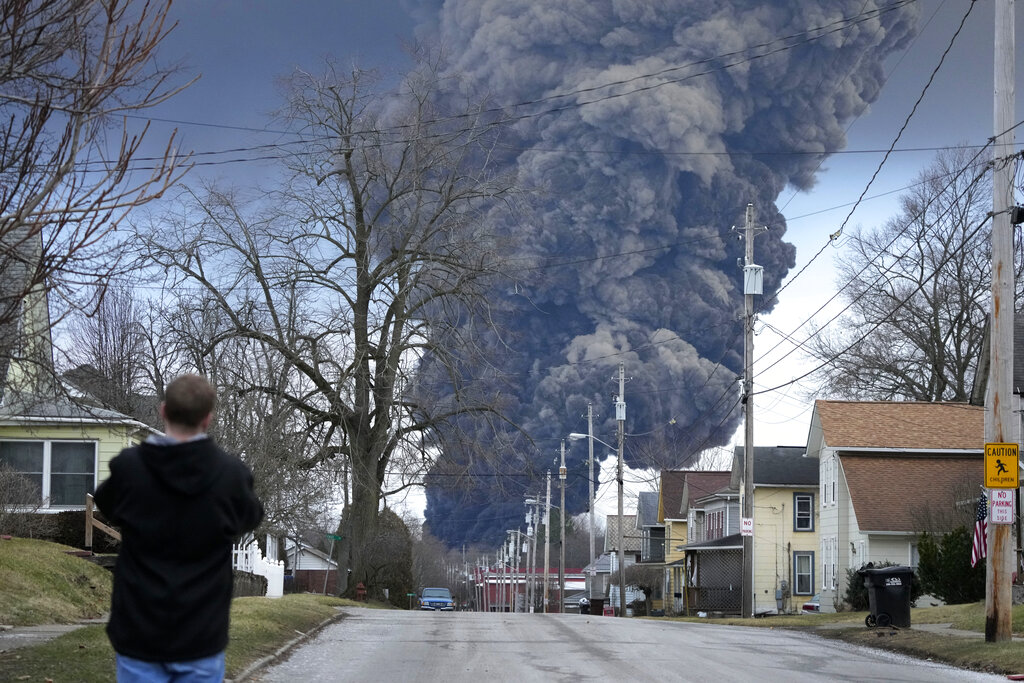
A town hall meeting is being held tonight in the Ohio village of East Palestine which was upended by a freight train derailment that spilled dozens of cars filled with toxic chemicals and the intentional burning of some of those hazardous chemicals.
The village invited affected residents to the meeting to discuss their ongoing questions and concerns, including ongoing smells, reports of sick or dead animals, the potential impact on drinking water, and more.
Health concerns remain even after families returned to their homes, now trying to resume their normal lives after the toxic train derailment last week along the Ohio-Pennsylvania border.
More than 50 cars derailed due to an alleged mechanical issue, spilling dozens of cars filled with toxic chemicals. Although nobody was hurt, many are worried about the safety of their air and drinking water.
“The Ohio River is very large and it’s a water body that’s able to dilute the pollutants pretty quickly,” said Tiffani Kavalec, Ohio’s Environmental Protection Agency Chief of the Division of Surface Water.
Authorities maintain they were doing their best when they chose to conduct a controlled burn of the toxic materials that spilled – to avoid an explosion. They do admit these chemicals did leech into tributaries, including the Ohio River.
Ohio’s Department of Natural Resources estimates about 3,500 dead fish following the derailment. Residents who were at least 10 miles from the accident report dead fish and chickens. Ohio Governor Mike DeWine is leery about the condition of Ohio’s drinking water.
“I think that I would be drinking the bottled water and continue to find out what the tests are showing, as far as the air,” Gov. DeWine said.
At least three toxic substances were released into the air, soil, or water according to the Environmental Protection Agency.
“Most people can be around these volatile organic compounds, at low levels, without really feeling health effects,” said Dr. Bruce Vanderhoff, director of the Ohio Department of Public Health. “However, at higher levels, especially over a longer period of time, then we can have longer term health effects and that’s why there is the concern around these compounds.”
One substance called Vinyl Chloride, which is used to make plastics like PVC piping, was diverted into a trench and burned off. Reports of a large plume of smoke and toxic smells spread across several cities. The chemical is a known carcinogen – and when it’s burned, releases similar gasses that were used in WWI. Concerns are widespread.
Gov. DeWine said he spoke with Norfolk Southern CEO Alan Shaw who promised the company would remain in the area until the damage was completely cleared. He was, however, surprised to learn the reason the state wasn’t notified about what was in the rail cars coming through Ohio.
“Even some rail cars did have hazardous material on board, and while most of them did not, that’s why it was not categorized as a high hazardous material train,” said DeWine. “Frankly, if this is true – and I’m told it’s true – this is absurd.”
Norfolk Southern is testing the air and water inside about 300 homes. Results will be released next week.
“The Guardian” reports about 4.5 million tons of toxic chemicals are shipped by rail every year – with one former Norfolk Southern engineer telling the paper, “The Ohio wreck is the tip of the iceberg,” and “a red flag” – saying that the next one could be cataclysmic.
The derailment has renewed calls for stringent federal oversight of the rail industry so other communities might be protected in the future.
The remainder of this article is available in its entirety at CBN